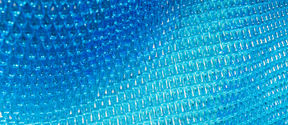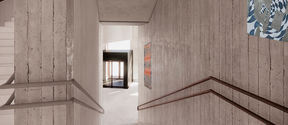Public art collections at Aalto University
The aim of public art across Aalto is to create a vibrant environment for experiencing the world through various perspectives and for embracing imagination, intuition, and exploration.

The theme of the public art collection at the Kide building chases the idea of waves. The wave also refers to the name of Aalto University, as the Finnish word aalto translates to a wave. In what different ways can the idea of waves be approached in contemporary art? For example, colours are waves, as are light and sound. An interesting point is also in technological development, where analog waves are curved, while digital waves are angular.
Waves have the concept of repetition, as do many art techniques, especially in traditional printmaking. In the office spaces on the second and third floors of the Kide building, there is graphic art from four artists: Inka Bell, Kari Laitinen, Sanna Hellikki Suova, and Sakke Yrjölä. At the main entrance, artist Baptiste Debombourg's steel artwork flows like an uninterrupted liquid infiltrating the space. The artwork brings a unique character to the building, which is also visible to those passing by on the tram. Debombourg's works are widely exhibited internationally. This is his first permanent artwork in Finland.
The purpose of public art is to create an inspiring environment on the campus that brings joy and new ideas to students, staff, and visitors.

Baptiste Debombourg designed In motion for the Kide building in a location where people pass by at different speeds. He wanted a reflective, mirror-like material that interacts strongly between the external and internal spaces of the building.
Due to its wave-like surface made of stainless steel, the reflected image is always unique. Outside the building, the artwork appears very different in various places during different seasons and times of day. The artwork continues in the building's lobby areas. Debombourg challenges us to consider where the artwork begins and ends.
Tours focusing on the public art at Marsio, Kide and Viima buildings are a part of Designs for a Cooler Planet festival.

Attend over thirty open seminars, talks, tours, film screenings and workshops.

More information
Outi Turpeinen, Manager, art and exhibitions
[email protected], tel. +358 50 431 4194
In 2017, Aalto University decided to comply with a one per cent art principle in its building projects. The one per cent art principle was first applied to the Radical Nature art concept in Aalto University’s main building, Dipoli.
The vision of public art at Aalto University is to address and raise questions about what it is to be a university, what we do together in society, and what constitutes the public. Public art is site-specific and connects with the diversity of the university and its post-disciplinary communities. Public artworks reflect this diversity through different art forms, materials, techniques and traditions.

The aim of public art across Aalto is to create a vibrant environment for experiencing the world through various perspectives and for embracing imagination, intuition, and exploration.

As a result of a naming competition, the Otakaari 2B building was given a new name

The themes, artists and drafts of the new buildings' art collections were published